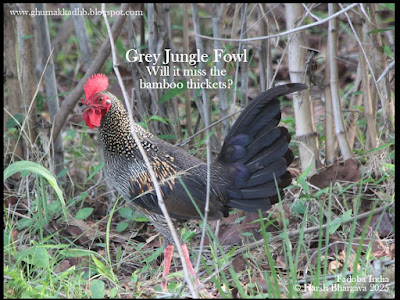Did you know that bamboo trees flower only once in their lifetime?
If so, what is the life of a bamboo tree?
What do the flowers of a bamboo tree look like?
For the answers to these and more questions, browse this picture story.
We recently witnessed the en masse drying up of bamboo groves in Tadoba Andhari Tiger Reserve (TATR) in Maharashtra India. On enquiry, we came to know of many Bamboo Mysteries, the title of this story.
On returning from Tadoba, Animesh did some AI-based search. Sharing below some of the findings. We have added our pictures wherever relevant. Hope it will intrigue you as much as it did to us. If you had experienced similar phenomenon with bamboos anywhere else, please do share. It will enrich our story.
Bamboo Flowering
Mass bamboo flowering, also known as gregarious flowering or synchronous flowering, is a remarkable and often mysterious phenomenon where all plants of a particular bamboo species, even those in widely dispersed geographical locations, flower simultaneously.
Here's what makes it so unique and significant:
* Extremely Long Intervals: Unlike most plants that flower annually, many bamboo species have incredibly long flowering cycles, ranging from 30-35 years to as long as 120 or even 150 years. According to our forest guide in Tadoba, bamboo flowering has occured after 40 years.
* Synchronicity: The most striking aspect is that all individual plants of a given species, regardless of their location, tend to flower at roughly the same time. This is believed to be a genetically programmed "biological clock" within the bamboo. Readers may browse our earlier story on Brahma Kamal flowers which also appear to have a biological clock. It flowers around the full moon, month after month, year after year! Click the link below to browse the picture story.
* Post-Flowering Die-off: In most cases, after mass flowering and producing seeds, the parent bamboo plants die off. This is a form of semelparity, where an organism reproduces once and then perishes. This can leave entire bamboo groves looking dead or lifeless. See the pictures below.
Ecological and Economic Impacts:
* Seed Production: The mass flowering leads to an abundance of seeds. This is thought to be an evolutionary strategy (the "predator satiation hypothesis") to overwhelm predators, ensuring that enough seeds survive to germinate and grow into a new generation.
* Rodent Outbreaks and Famine: The sudden availability of a massive food source (bamboo seeds) can lead to a surge in rodent populations. Once the seeds are consumed, these increased rodent numbers may then turn to agricultural crops, leading to widespread crop damage and, historically, famine in regions that depend on these crops (e.g., the "mautam" famine in Mizoram, India, linked to Melocanna baccifera flowering). We only hope that TATR forests are not impacted severely by this bamboo flowering.
* Habitat Impact: For animals like giant pandas, which rely heavily on bamboo as a food source, mass flowering can be devastating if their habitat doesn't contain multiple bamboo species that flower at different times, allowing them to migrate to unaffected areas. Though the spotted deer, sambhar and barking deer are not dpendent upon the bamboo for food, but bamboo makes up for more than 40% of all trees in TATR. So, mass flowering and subsequent dying of bamboos in TATR will alter the ecological balance at least for few years till the seeds germinate and new bamboo crop comes up.
* Regeneration: While the die-off can be dramatic, the seeds produced can germinate and grow into new bamboo plants, eventually regenerating the forest. Some rhizomes (underground stems) may also recover. Here is a picture of teak regeneration observed by us in Tadoba.
Why does it happen?
The exact triggers for mass bamboo flowering are still largely a mystery to scientists. The prevailing hypothesis is that it's a genetic trait, like a built-in biological alarm clock that signals the plants to flower after a certain period of growth. Since many bamboo plants are essentially clonal reproductions from a mother plant, they share this genetic predisposition and flower simultaneously. They die simultaneously and hopefully will regenerate simultaneously.
Mass bamboo flowering (and subsequent dying) is a natural phenomenon that highlights the intricate and sometimes unpredictable cycles of the natural world.
The more you venture into the wild, the more you unearth some or the other mystery about Nature.
Sharing below few links to our earlier stories which showcase various uses of bamboo.
Bamboo Huts in a Assamese Village - using eco-friendly building material
Driving through the Bamboo Land - Various handicrafts made of bamboo
Coracle The Bamboo Boats - Not for the weak hearted
Thanks for browsing. Stay connected and do share your feedback. A few words would be enough to encourage us.
- Harsh-the-Ghumakkad with Animesh Bhowmick/ Tadoba and Secunderabad/ 13th June 2025
#bambooflowering #massflowering #synchronousflowering #PredatorSatiation #Regeneration #bamboodying #bamboouprooting #ghumakkadhb #TATR #tadoba #tigerreserve #BambooDeathEnmasse #ghumakkadharsh




































































